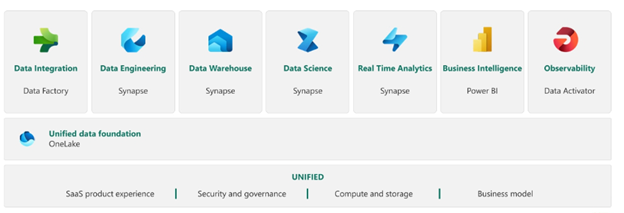Key Takeaways
- Microsoft Fabric seamlessly integrates various data operations into an accessible, unified framework.
- Collaboration is easier and making real-time, data-driven business decisions is simplified.
- Unified storage in a multi-cloud platform keeps information available to everyone through Power BI.
A vast amount of data flows through organizations, but not all of it is easily accessible. Data roadblocks, from silos to legacy systems, prevent users from having real-time access to information, ultimately slowing down decision-making.
Data projects have many subsystems, and every subsystem needs a different class of products from different vendors. In short, data integration is complex, fragile, and expensive. But it doesn’t have to be.
Microsoft Fabric was built to help foster a data culture, enabling anyone to quickly go from source systems to stunning Power BI visuals.
The Problem: Data Complexity
Multiple vendor solutions often fragment modern data stacks and make the flow of information slow and inefficient, costing organizations time and productivity. The 2023 Work Index annual report highlights the workforce’s inability to keep up with the inflow of data.

With each tool in the data ecosystem — sources, extraction, storage, transformation, and reporting — organizations must make decisions about cloud providers, governance, methodologies, cost models, security, and maintainability.
Security, responsiveness, and effectiveness are all challenges in a fragmented ecosystem.
Business leaders want answers to theoretically simple questions:
- How do I unify all disparate data sources cost-effectively?
- How do I minimize security breaches and risks?
- How do I improve analytical agility for my organization?
- How do I ensure business users utilize the insights to get value from my technology investments?
In complex data ecosystems, data teams must spend their time attempting to maintain a complex infrastructure rather than deliver on the above questions quickly.
The Solution: Microsoft Fabric
Microsoft Fabric is a unified, end-to-end analytics platform that brings together all the data and analytics tools that organizations need to go from data sources to the datalake to the business user.
For Microsoft 365 and Power BI users, Microsoft Fabric expands capability by bringing organizational data under one umbrella with built-in governance and organization-wide guidelines. Data professionals can easily run comprehensive calculations and report findings all in one platform.

There are a number of features that showcase Microsoft Fabric’s strong disruptive potential.
Unified Storage
With vast amounts of information being used within organizations each day, datalakes are essential. Microsoft’s OneLake is a built-in software-as-a-service (SaaS), multi-cloud datalake that prevents data duplication and silos. Having only one version of data makes collaboration among users easier and more accurate.
Personas
Another valuable feature of Fabric is its inclusive design for different user personas including data engineers, data analysts, and data scientists.
For example, Fabric equips data scientists to run, train, test, and apply their models in the lakehouse ecosystem and even expose that data through the lakehouse after they've run their models and experiments.
Real-Time Access
Microsoft Fabric’s ability to efficiently stream structured and semi-structured data within the same ecosystem is unique. Users can now access DirectQuery using AI-driven Power BI, which provides real-time access to data while maintaining performance.
- Watch a demo of Microsoft Fabric in action.
Success with a Unified Ecosystem
To be a leader in the marketplace, adapting to change by embracing more effective technology solutions is essential. Microsoft Fabric is a groundbreaking product that strengthens your current technology investments. By fully integrating your other Microsoft resources and minimizing costs through a unified platform, your organization will benefit from a powerful data ecosystem that’s poised to scale.
To learn more, check out our Exploring Microsoft Fabric webinar featuring a technical discussion of how this product is revolutionizing data ecosystems and a live use-case demonstration.


